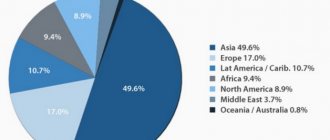Today, most people cannot imagine their life without the Internet. We are accustomed to the fact that with its help we can find the answer to all our questions. The Internet will tell you what weather awaits us in the coming days, how to cook your favorite dish, make repairs yourself and a lot of other useful information. And many people prefer to communicate through various instant messengers on the Internet.
Despite the fact that almost every person uses the Internet in everyday life, only a few users know when it appeared and who invented it. In this publication, we will briefly look at the history of the creation of the World Wide Web, talk about who invented it and in what year it appeared.
First version of the Internet
On October 29, 1969, for the first time in the world, two servers located in different American states were connected to each other. This date is considered the day the Internet was created, since the file transfer was successful. The network was called ARPANET; it became a kind of basis for the creation and development of other communication networks.
In 1983, ARPANET began using the TCP IP protocol for data transmission, which is still used today. In the 90s of the last century, the ARPANET network was liquidated, and its servers were joined to other networks.
How ARPANET became an international network
One of the first ARPA computing centers
With the development of ARPA, developers saw another advantage of such networks. If necessary, it was possible to intelligently redistribute the computing power of existing computers instead of purchasing new ones.
In just a few years of the project's existence, ARPA managed to reduce many budget requests for the purchase and modernization of computer equipment. All network participants had terminal access to the most powerful server stations and could use any necessary power for data processing.
The network between computers made it possible to distribute new software developments faster and collect feedback from users. What is now an integral part of even the simplest App Store app was considered the height of technological progress in the mid-70s.
Such successes allowed the developers to receive additional funding. Satisfied with the results of the program, officials were able to allocate more than $1 billion in additional funds for the ARPANET project, which were transferred from the ballistic missile research program.
The United States understood that the future lies not only in striking power, but also in reliable means of communication.
One of the first network routers
Additional funding made it possible to attract more qualified specialists with new and interesting ideas to the development. This is how the first traffic routing and queues for data packets appeared on the ARPANET network.
In those days, all communication channels were analog, and while the established channel between two devices was idle, other terminals could not use it. The human factor was of great importance when at the distribution switch the operator connected the sender and receiver of the signal. The person simply did not know whether the established communication channel was still in use or whether it could be disabled for new connections.
Then a special queue protocol was developed for ARPANET. The transmitting device could independently monitor the occupancy of other communication channels and use them during downtime. This greatly reduced the signal transit time within the network and saved users from waiting time before starting data transfer.
With the advent of routing, it became possible to create an extensive network with several available channels between two end terminals. The sender could dynamically change the route during data transmission if it found a more accessible and faster path for transmitting the signal.
FTP , tools for remote access and launching TELNET were implemented .
ARPANET coverage by 1982
In 1973, it was decided to make the network international. For a long time, the US military did not want to extend communication channels beyond the borders of its state, and it was the Ministry of Defense that financed the development of ARPANET. The researchers managed to push through the idea of creating a global network; several institutions from the UK and Norway were the first to gain access to the American communications hub.
In 1977, just over 100 computers were connected to the ARPANET network, and already in 1983 the number of clients exceeded 4,000 devices. The network covered organizations in all states of America, including the island of Hawaii. The signal was transmitted across the ocean using satellite communications. A similar channel existed between the United States and European countries.
The cost of sending one email on this network was estimated for the US budget at $0.5.
Abbreviation WWW
In 1991, the concept of the World Wide Web was invented by British physics and programming scientist Tim Berners-Lee. This phrase doesn’t mean anything to most people on the Internet, but its abbreviation – WWW – is well known to almost every user of the World Wide Web. WWW is a global network that consists of a huge variety of documents interconnected. The transition from one document to another is accomplished by simply clicking on a hyperlink.
Who invented the World Wide Web
Users of the global network are unlikely to think when entering the Internet who came up with it and brought the project to life. If the prerequisites for the emergence of the Internet were laid in the USA, then the idea of creating a global network originated with researchers at the leading European research center CERN. British scientist Tom Berners-Lee invented and created the World Wide Web. He worked for two years to invent the HTML markup language, the HTTP protocol, URLs and other standards.
Belgian researcher Robert Caillot was Burns-Lee's colleague at CERN, and is also one of the founders of the Internet.
Today…
Nowadays, a huge number of people all over Russia use the Internet. Some people use it for work or study, others for entertainment purposes and for communication.
Providers in Moscow and the region offer high access speeds, thanks to which users can not only read materials, but also watch high-quality video in real time, without worrying that the picture will stop.
One of these providers is the telecom operator Network Fast System Telecom, which offers Internet connection in the city of Domodedovo.
When did the first Internet appear in Russia?
The Internet appeared in Russia much later than in the United States. This was at the Institute of Atomic Energy and the Institute of Advanced Training of the Automotive Industry.
For the first time in Russia, connection to the World Wide Web was made on August 22, 1990.
- The registration of the first Soviet domain (.su) in the international domain directory took place on September 19, 1990.
- The Russian Federation domain (.ru) was first registered on April 7, 1994
- On the territory of the Russian Federation, the official date for celebrating Internet Day is September 30.
A Brief History of Internet Systems and Services
At the beginning of its existence, the Internet did not have a convenient way to search for the necessary information. In order to find any useful information in its vastness, it was necessary to know what address the site was located at. Then you had to enter this address into the search bar, and then for a long time follow the links that were highlighted with underlining.
YAHOO
The pioneer among search engines is YAHOO. Jerry Yang and David Filo, the creators of the search engine, needed to find as much information as possible about teams that played basketball. While their supervisor was absent, free time was freed up to find a solution. And at the very beginning of 1994 it was found. The “Guide” they created at that stage of the development of the Internet was a breakthrough moment in navigation. It was a directory of all sites.
Since then, the rapid development of search on the World Wide Web has begun, as advertisers have invested significant capital in it. It was profitable for them to place paid advertisements in search engines, since a large number of people used them every day.
A huge achievement of Google is the ranking of links and the ability to search for the necessary information by phrase. A simple rule for determining the best pages is the following expression: if site A contains a link to site B, then for the second one this is a definite plus. This is called a citation index.
Today, without a search bar in the browser, not a single user can navigate among the endless variety of different sites on the Internet.
Yandex
For the Russian-speaking part of the Internet, the search starts with Rambler. It appeared in the Russian segment in 1996, 3 years after American search engines. It began functioning on the global network within a year, and today it is consistently among the top ten search engines in the world. In the Russian segment, it is the leader among search engines.
Where does the Internet from the Russian provider come from?
Today there are many options for transferring data. More often, for this purpose, a connection via a cable with optical fiber is used, and where it is not possible to install this wire, the network is transmitted from a satellite. This work belongs to special provider companies.
The provider that provides services in your city installs a powerful server (and more than one) on its side. The latter are connected through wires, radio channels or using satellite communications from larger providers located in other cities. That is, they get the Internet from the giants.
The servers are connected to each other by a huge web (translated from English as “Web” – the second name of the network). It includes fiber optic cables that are capable of transmitting information over vast distances. For example, the Internet comes from the United States of America to the Russian Federation thanks to a huge cable with a diameter of up to 69 mm. It was laid along the bottom of the Atlantic Ocean.
Useful information about what the Internet has deprived us of can be read here.
Postal services
Email has been an integral companion of the Internet throughout its existence. The development of the first email client, through which users could read and send mail via the World Wide Web, was carried out in 1971.
Some believe that the history of email dates back to 1965, when Tom Van Valeck and Noel Morris wrote the Mail program. But the operation of this application was possible only on computers on which the CTSS operating system was installed. It was possible to send messages only to a computer with the same OS that was connected to the local network.
Hotmail
Other researchers consider the starting point of email to be July 4, 1996, since it was on that day that the commercial use of the Hotmail email service began. His revolutionary step was the ability for users to check their email account from any device with access to the World Wide Web.
Gmail
This email service began operating in the summer of 2001. At first it was available only to a limited number of users. The ability to use the Gmail service for a wider circle began in April 2004. The most important advantage of this mail system was the huge volume of letters for that time, which was allocated to each user. It was 1 GB, while competitors had a maximum of 10 MB. Therefore, Gmail occupied a leading position on the Internet at that time and to this day it is one of the most popular email services.
Yandex Mail and Mail.ru
Email Mail.ru began functioning on the Russian Internet back in 1998. It is the oldest postal service in the Russian Federation.
In the summer of 2000, another mail resource appeared in Russia - Yandex.Mail. Its advantage was the detection of spam and the processing of all attachments by antivirus directly on the Yandex server.
First attempts
The first attempts and projects to create the Internet date back to the early 1960s. Namely, in 1962, Joseph Licklider published a series of notes that spoke about the structure of the “Galactic Network”. The idea was to conveniently transfer data, similar in principle to the modern Internet.
In 1962, Paul Baran detailed a system in which all computers on the World Wide Web were equal, and if part of the chain were destroyed, it would still work. The history of the creation of the Internet was only at the theoretical level at that time. It was imagined in general terms, but no one took on the implementation of such a complex, expensive and incomprehensible project for the average person.
The practical creation of a worldwide communication network is a very big and complicated story. Back in 1957, when the USSR launched its first space satellite, the United States thought that during the war it would not hurt to have a good data exchange system. Some large American universities took up development and created the APRANET network. Large-scale funding was allocated: the capitalists no longer considered expenses when socialism became the main monster under the bed. The Cuban Missile Crisis and other Cold War battles fueled government interest in creating the Internet.
Officials in the US saw benefits in creating a computer network because:
- During a nuclear war, long-wave communications will become impossible to use for long-distance communications.
- Any other communication systems could be disabled by damage.
- A computer network is able to operate even if its individual segments are destroyed.
The next step, after the first successful attempt to implement the APRANET network, was the successful sending of email over the network in 1971. In 1973, Great Britain and Norway were involved in the experiment. Thus, the network began to be considered international. In the 70s, email forwarding was very popular. This is how various notifications were made and news boards appeared. The Internet is beginning to slowly invade people's lives, but only in the West. There are no similar developments in the country of the Soviets.
Browsers
Browsers are designed to navigate between sites on the global network. Today, users have the opportunity to choose the most convenient tool for accessing the Internet.
World Wide Web
The struggle for the title of the best guide on the World Wide Web began in the 90s of the last century. One of the first such programs was called the World Wide Web. Its abbreviation, WWW, is often used to refer to the Internet. Later the browser was given the name Nexus, but lost its position, giving way to the leadership of the most advanced browsers.
Mosaic
A small number of people using the Internet in Russia are familiar with this tool for “travelling” on the World Wide Web, but this is the first browser with a graphical interface. There is a version that such popular browsers in the 90s as Internet Explorer and Netscape Navigator used the code of this open project at the initial stage of its operation.
Nescape Navigator
This is the first browser with a search bar, which existed from 1994 to the end of December 2007. Most of the users of the Russian Federation became acquainted with the Internet thanks to this browser.
Google Chrome
Currently, it is difficult to imagine the modern Internet without this browser, and it seems that it has existed from the very beginning of the creation of the World Wide Web. However, the year of its appearance is only 2008. Today, its source code and engine are used by many popular browsers, including Yandex and Opera.
History of technology creation
Today there are about 970 million websites, all continents and countries are connected to the network. The story begins in the 20th century - a time of massive development of technology. The basis for the development of the network were ordinary LANs - electronic computers. Scientists began to think about the possibility of transmitting data over distances, and the US military department took over the work.
Creation of distributed networks, ARPLANET
In 1957, the United States learned that the USSR had deployed its missiles in Cuba. Thus, the threat of war ceased to be hypothetical. America's military has accelerated the pace of work to create a long-distance transmission network. The reasons are simple - in a war, any local means of communication can be disabled in the shortest possible time, while distributed networks without a single central unit will remain in working order.
In 1957, scientists from 4 institutes and DARPA employees worked on the task. The result was the Arplanet network, which appeared in 1969. It had only 4 nodes, the system did not meet the stated requirements. However, today, when asked in which country the Internet first appeared, the answer is usually the USA. But it would be more appropriate to say that this is the country where the Internet came from, because many scientists, including from Europe, shared the laurels of its creators.
Global connectivity
As soon as the first satisfactory results were obtained, scientists from other countries joined the research. The team of 150 people instantly grew. The project was funded by the US Department of Defense. The global approach was developed by ARPA employees, in particular, J. Licklider - it was he who conducted a number of necessary studies, without which the Internet would not have appeared.
Packages and protocols
Technology and information transfer protocols were the main problem of the project. L. Kleinork joined the task. In his 1961 study, he described in detail communication protocols, which are based on information transfer technology.
Initially, the line capacity was low due to the use of telephone cables. Any interference resulted in a connection failure. Kleinork suggested splitting the file into packets and sending information in small portions. The recipient can collect all the packets and read the full text. The theory was proven in a communication session between Massachusetts and California. The broadcast confirmed the success of the initiative and proved that the time difference is completely unimportant.
But now another problem arose - separate lines were required for the full transmission of information.
Open network and the name Internet
Some people believe that the modern name comes from the Cyclades project. It was the French developers who set the main goal of connecting to other similar networks, that is, Inter-net. The researchers did not have such strong financial support as in the United States, so the goal was only to speed up the interaction between the links in the chain.
French scientists have achieved rapid connection and transmission while preserving the full package of information. This system suited everyone - the military, individuals, companies.
The only problem was that the package was not opened on the transfer machine, but was only sent - this is inconvenient. The key decision appeared only after the approval of communication standards, which was developed by ISO. The document defined the principles and levels of interaction between networks and guarantees of security of use. Now the data went from user to user, bypassing intermediate links.
Internet Day in other countries
In Europe and the United States, Internet Day is celebrated on April 4th. There are two versions why this particular date was chosen.
- Firstly, the spelling of 4.04 is very similar to the 404 error notation, which means that the page you are looking for is not in the web www.
- Another version has a religious basis. It is generally accepted that the patron of the Global Network is Saint Isidore of Seville, who was canonized by the Catholic Church. It is April 4th that is the day of his ascension. In 2000, the candidacy of Isidore of Seville was officially confirmed by the Vatican. To justify its decision, the church cited the saint's use of cross-references in his writings, which were the prototype of the hyperlinks used today. Patron of the World Wide Web as a result of an open vote, which was initiated by the Vatican on the Internet site it supervised. This means that the choice of candidate was approved by users of the global web.
In some states, the day of the creation of the Internet is celebrated on the day when their own national domains appeared. For example, December 14th is considered Internet Day in Ukraine, and Uzbekistan celebrates the emergence of the World Wide Web on April 29th.
RATES
There has long been an anecdote about the method of paying for the Internet of those times:
Remember the hungry years? Internet with cards...
Cards for replenishing accounts were sold in denominations from 10 to 100 USD. The dollar exchange rate on March 31, 2001 was 28 rubles 74 kopecks, and e. equaled approximately 25 rubles (+- 3 rubles, depending on the operator).
Here are the prices of one popular Moscow Internet service provider dated March 31, 2001. Prices are indicated per hour of Internet access at a speed of several tens of kilobytes per second.
Let us recall that the average Russian salary in 2015 was 33,268 rubles, and in 2000 it was 2,266. An ordinary Russian, subject to complete starvation and accumulation of debts for utilities, could afford 50 hours of network use during the day or 100 hours at night .
Who owns the Internet in Russia
The Russian-speaking segment of the Internet is Runet. It hosts websites and other services that use the Russian language for communication and information. Russian is the second most popular language on the Internet. The first place, of course, remains with English. The formation of the Russian-language segment began in the early 90s of the last century, simultaneously with the rest of the global network. The term “Runet” began to be used in 1997. There are different interpretations of this concept. Some argue that this is a list of domains in the ru zone, while others believe that this is a Russian Internet network.










